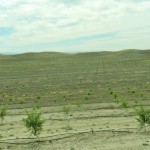
Maybe the rumors were true. Maybe the Stanislaus aquifer really is flowing uphill.
That’s one explanation for what’s going on near Hughson and Denair, where people’s wells have suddenly started running dry. Both towns are considerably downslope from the thousands of acres of new orchards on Stanislaus County’s east side. That’s where powerful pumps have been spreading millions upon millions of gallons of groundwater on what was once arid grazing land.
A recent Modesto Bee story highlighted the plight of the Bakker family of Denair, whose well ran dry June 2. They are one of dozens of families now facing the prospect of drilling deeper at a considerable and unanticipated expense.
A major reason for their dire situation is California groundwater law (or absence thereof). In a supposedly over-regulated state, California authorities have failed time and again to impose any regulation or even oversight on groundwater use. The latest review of the state’s groundwater status from the Department of Water Resources dates back to 2003.
In essence, the state has ceded groundwater regulation to counties and water districts. The underlying principle is simple: according to California law, in most areas of the state, overlying land owners may extract percolating groundwater and put it to beneficial use without approval from the State Board or a court.
Needless to say, this particular law invites abuse. For one thing, what’s to be done when the “overlying land owner” begins draining his neighbor’s well water? The law is silent.
In the absence of regulation, it’s no wonder that aquifers are running dry all over the state. Thirty percent of water deliveries in California are in the form of groundwater, and that’s in average rainfall years. In drought years the percentage is much higher.
In the San Joaquin Valley, entire cities rely on groundwater as their sole water source. One of those cities is Fresno, the fifth largest city in the state. Nevertheless, it’s still easy for anyone with the pumping power to tap the aquifer without limit. Thus, when your well goes out because your neighbor has drained the water from under you, you have no legal recourse.
The effects of over drafting aren’t limited to water shortages. A large area of the San Joaquin Valley has literally sunk due to subsidence. Subsidence occurs when over drafting takes away ground support. The area from Los Banos to Kettleman City—some 1500 square miles—features the largest area of subsidence in the world. Subsidence often leads to compaction, a compression of the earth so dense that surface water tends to “perch” and evaporate rather than percolate into the aquifer.
The ultimate effect of over drafting is desertification. Before that happens, those unfortunate enough to have their wells and water systems run dry must bear the expense of drilling deeper or importing water from elsewhere. And when subsidence and compaction cause damage to infrastructure and formerly fertile land, the public bears the expense.
In Denair, the Bakker family is trying to figure out how to pay for a deeper well. Sooner rather than later, many more of us will be facing our own unanticipated expenses. Under current California law, we all pay the bill when the public water table becomes a private watering trough.
